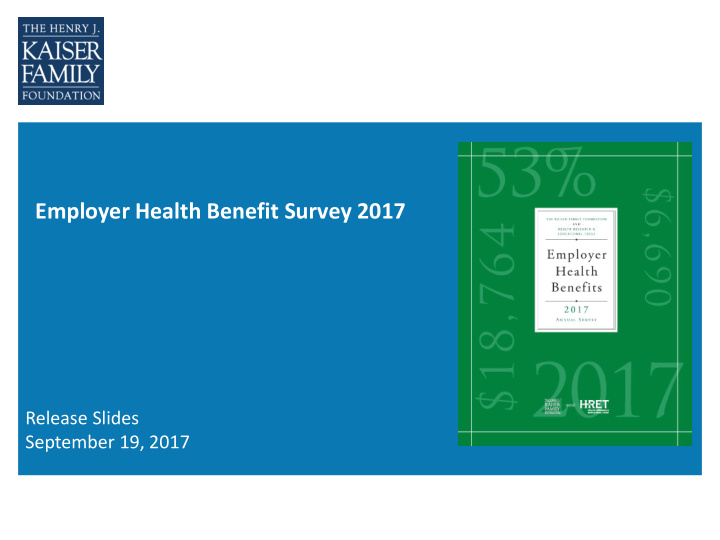



Employer Health Benefit Survey 2017 Release Slides September 19, 2017
Drew Altman President and CEO Kaiser Family Foundation
MOST OF THE HEALTH SYSTEM IS STABLE MEDICARE NON-GROUP EMPLOYER PROVIDED MEDICAID MARKET COVERAGE Growth in per Growth in per Increase in beneficiary costs Benchmark beneficiary costs family coverage premium growth 20% 8% KFF/HRET 2017 EHBS 4% 3% 3% 3% 2% 2% 2% 1% 1% 1% ’15 ‘16 ‘17 ’15 ‘16 ‘17 ’15 ‘16 ‘17 ’15 ‘16 ‘17 Source: ( 1.) Non-Group Market: 2014 – 2017 Marketplace Average Benchmark Premiums – Kaiser Family Foundation (2.) Employer Health Benefits: 2014, 2015, 2016, 2017 Employer Health Benefits Survey – Kaiser Family Foundation (3.) Medicaid: HHS 2016 Actuarial Report of the Financial Outlook for Medicaid (4.) Medicare: 2017 Annual Report of The Boards of Trustees of The Federal Hospital Insurance And Federal Supplementary Medical Insurance
Gary Claxton Vice President and long-time study director Kaiser Family Foundation
Matthew Rae Senior Policy Analyst and study co-author Kaiser Family Foundation
Figure 1
Figure 2
Figure 3 Average Annual Increases in Premiums for Family Coverage Compared to Other Indicators, 2000-2017 20% Overall Inflation Workers' Earnings Family Premiums 18% 16% 14% 13.0% 13.0% 12% 11.0% 10.0% 10.0%* 10% 9.0% 9.0%* 8% 6.0%* 6% 5.0% 5.0% 5.0% 4.0% 4.0%* 4.0% 3.9% 3.9% 4.0% 3.0% 3.9% 3.8% 4% 3.5% 3.0% 3.3% 3.2% 2.7% 3.0% 3.0% 3.0% 3.7% 2.3% 3.5% 2.3% 2.4% 3.3% 2.4% 2.0% 1.8% 2.3% 3.1% 2.7% 2% 2.6% 2.6% 2.2% 2.2% 2.2% 2.1% 2.0% 2.0% 1.6% 1.7% -0.7% -0.2% 1.1% 1.1% 0% 2000 2001 2002 2003 2004 2005 2006 2007 2008 2009 2010 2011 2012 2013 2014 2015 2016 2017 -2% * Estimate is statistically different from estimate for the previous year shown (p < .05). SOURCE: Kaiser/HRET Survey of Employer-Sponsored Health Benefits, 1999-2017. Bureau of Labor Statistics, Consumer Price Index, U.S. City Average of Annual Inflation (April to April), 1999-2017; Bureau of Labor Statistics, Seasonally Adjusted Data from the Current Employment Statistics Survey, 1999-2017 (April to April).
Figure 4
Figure 5
Figure 6
Figure 7
Figure 8
Figure 9
Figure 10
Figure 11
Figure 12 Percentage of All Workers Covered by Their Employer's Health Benefits, Both In Firms Offering and Not Offering Health Benefits, by Firm Size, 1999-2017 All Small Firms (3-199 Workers) All Large Firms (200 or More Workers) ALL FIRMS 100% 90% 80% 69% 69% 68% 68% 67% 66% 66% 66% 70% 65% 65% 64% 63% 63% 63% 62% 62% 62% 61% 61% 60% 65% 63% 63% 62% 62% 61% 59% 60% 60% 59% 59% 59% 58% 58% 57% 56% 56% 56% 55% 50% 55% 55% 55% 54% 53% 53% 52% 52% 50% 50% 50% 49% 48%* 47% 46% 45% 40% 44% 44% 43% 30% 20% 10% 0% 1999 2000 2001 2002 2003 2004 2005 2006 2007 2008 2009 2010 2011 2012 2013 2014 2015 2016 2017 * Estimate is statistically different from estimate for the previous year shown (p < .05). SOURCE: Kaiser/HRET Survey of Employer-Sponsored Health Benefits, 1999-2017.
Figure 13
Figure 14
Figure 15
Figure 16
Figure 17
Figure 18 Percentage of Covered Workers Enrolled in a Plan with an Out-of-Pocket Maximum for Single Coverage, 2009-2017 Covered Workers with an OOP Maximum OOP Maximum Above $3,000 OOP Maximum Above $6,000 100% 98%* 98% 98% 90% 94%* 88% 87% 80% 83% 82% 81% 70% 57% 60% 55% 49% 50% 44%* 38% 38% 38% 40% 35% 31% 30% 20% 19% 19% 19% 18% 16% 10% 15%* 15% 13% 13% 0% 2009 2010 2011 2012 2013 2014 2015 2016 2017 * Estimate is statistically different from estimate for the previous year shown (p < .05). NOTE: OOP refers to ‘out -of- pocket.’ Out -of-pocket maximums reported are for in-network services. Covered workers without an OOP maximum are considered to be exposed to at least the specified threshold. Some of these workers may be enrolled in plans whose cost-sharing structure has other limits that make it impossible to reach the specified threshold. SOURCE: Kaiser/HRET Survey of Employer-Sponsored Health Benefits, 2009-2017.
Figure 19
Figure 20
Figure 21
Figure 22
Exhibit 6: Figure 23 Among Firms Offering Health Benefits, Percentage of Firms Offering Various Wellness and Health Promotion Activities and Incentives, by Firm Size, 2017 All Small Firms (3-199 Workers) All Large Firms (200 or More Workers) 38%* Offers Health Risk Assessment 62%* Health Risk Assessments Incentive for Completing 5%* Health Risk Assessment 32%* 21%* Offers Biometric Screening 52%* Biometric Screenings Incentive for Completing 5%* Biometric Screening 28%* Incentive for Meeting 2%* Biometric Outcomes 7%* 58%* Offers Specific Wellness Programs 85%* Wellness Programs Incentive for Participating In 7%* or Completing Wellness Programs 27%* 0% 20% 40% 60% 80% 100% * Estimate is statistically different between All Small Firms and All Large Firms estimates (p < .05). NOTE: 'Specific Wellness Programs' include 'Programs to Help Employees Stop Smoking', 'Programs to Help Employees Lose Weight', or 'Other Lifestyle or Behavioral Coaching'. SOURCE: Kaiser Family Foundation and Health Research & Educational Trust, Employer Health Benefits Survey, 2017.
Figure 24
Figure 25
Figure 26
Today’s Web Briefing Will Be Recorded Read the report, and find a link to today’s presentation, at kff.org/ehbs
Contact Information Craig Palosky , Kaiser Family Foundation Email: CPalosky@KFF.org Phone: 202-347-5270
Recommend
More recommend